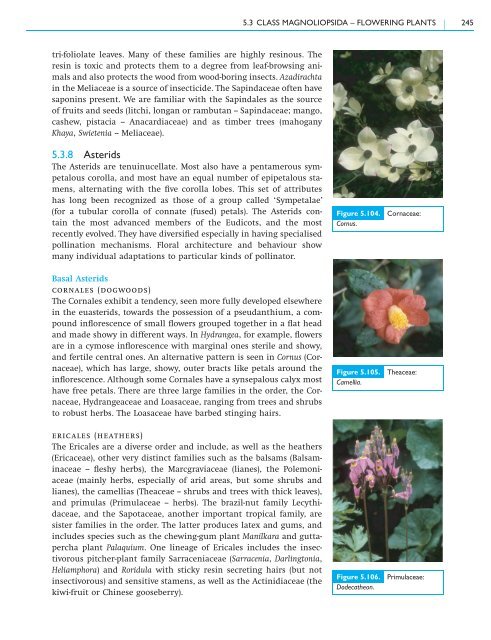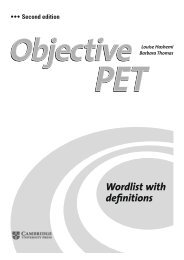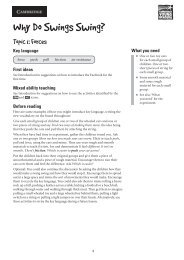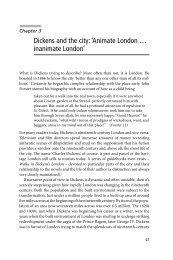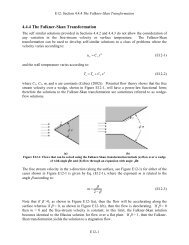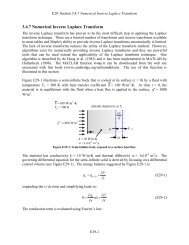5.3 Class Magnoliopsida – flowering plants - Cambridge University ...
5.3 Class Magnoliopsida – flowering plants - Cambridge University ...
5.3 Class Magnoliopsida – flowering plants - Cambridge University ...
Create successful ePaper yourself
Turn your PDF publications into a flip-book with our unique Google optimized e-Paper software.
tri-foliolate leaves. Many of these families are highly resinous. The<br />
resin is toxic and protects them to a degree from leaf-browsing animals<br />
and also protects the wood from wood-boring insects. Azadirachta<br />
in the Meliaceae is a source of insecticide. The Sapindaceae often have<br />
saponins present. We are familiar with the Sapindales as the source<br />
of fruits and seeds (litchi, longan or rambutan -- Sapindaceae; mango,<br />
cashew, pistacia -- Anacardiaceae) and as timber trees (mahogany<br />
Khaya, Swietenia -- Meliaceae).<br />
<strong>5.3</strong>.8 Asterids<br />
The Asterids are tenuinucellate. Most also have a pentamerous sympetalous<br />
corolla, and most have an equal number of epipetalous stamens,<br />
alternating with the five corolla lobes. This set of attributes<br />
has long been recognized as those of a group called ‘Sympetalae’<br />
(for a tubular corolla of connate (fused) petals). The Asterids contain<br />
the most advanced members of the Eudicots, and the most<br />
recently evolved. They have diversified especially in having specialised<br />
pollination mechanisms. Floral architecture and behaviour show<br />
many individual adaptations to particular kinds of pollinator.<br />
Basal Asterids<br />
cornales (dogwoods)<br />
The Cornales exhibit a tendency, seen more fully developed elsewhere<br />
in the euasterids, towards the possession of a pseudanthium, a compound<br />
inflorescence of small flowers grouped together in a flat head<br />
and made showy in different ways. In Hydrangea, for example, flowers<br />
are in a cymose inflorescence with marginal ones sterile and showy,<br />
and fertile central ones. An alternative pattern is seen in Cornus (Cornaceae),<br />
which has large, showy, outer bracts like petals around the<br />
inflorescence. Although some Cornales have a synsepalous calyx most<br />
have free petals. There are three large families in the order, the Cornaceae,<br />
Hydrangeaceae and Loasaceae, ranging from trees and shrubs<br />
to robust herbs. The Loasaceae have barbed stinging hairs.<br />
ericales (heathers)<br />
The Ericales are a diverse order and include, as well as the heathers<br />
(Ericaceae), other very distinct families such as the balsams (Balsaminaceae<br />
-- fleshy herbs), the Marcgraviaceae (lianes), the Polemoniaceae<br />
(mainly herbs, especially of arid areas, but some shrubs and<br />
lianes), the camellias (Theaceae -- shrubs and trees with thick leaves),<br />
and primulas (Primulaceae -- herbs). The brazil-nut family Lecythidaceae,<br />
and the Sapotaceae, another important tropical family, are<br />
sister families in the order. The latter produces latex and gums, and<br />
includes species such as the chewing-gum plant Manilkara and guttapercha<br />
plant Palaquium. One lineage of Ericales includes the insectivorous<br />
pitcher-plant family Sarraceniaceae (Sarracenia, Darlingtonia,<br />
Heliamphora) andRoridula with sticky resin secreting hairs (but not<br />
insectivorous) and sensitive stamens, as well as the Actinidiaceae (the<br />
kiwi-fruit or Chinese gooseberry).<br />
<strong>5.3</strong> CLASS MAGNOLIOPSIDA <strong>–</strong> FLOWERING PLANTS 245<br />
Figure 5.104. Cornaceae:<br />
Cornus.<br />
Figure 5.105. Theaceae:<br />
Camellia.<br />
Figure 5.106. Primulaceae:<br />
Dodecatheon.


